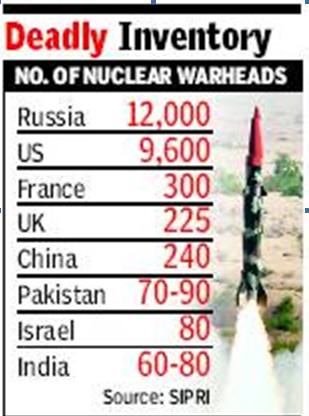Nuclear arsenals: India, China, Pakistan
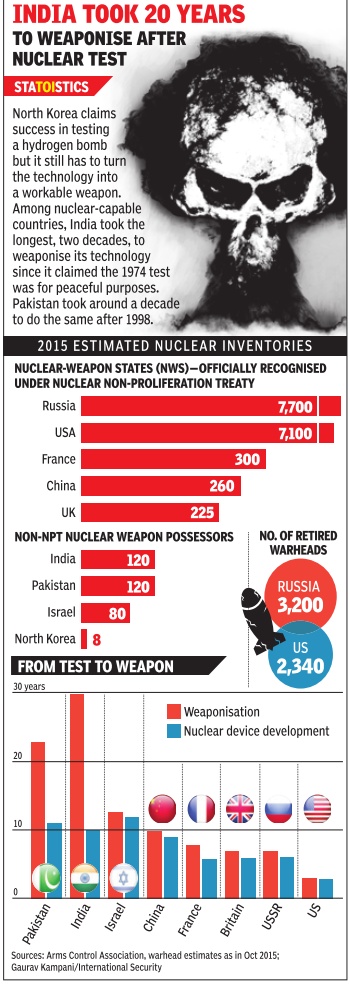
This is a collection of newspaper articles selected for the excellence of their content. |
Contents |
Nuclear tests

The Times of India, Sep 18 2015
The Comprehensive Test Ban Treaty aimed at banning nuclear tests is criticised as a tool of the nuclear haves to maintain their monopoly. Data shows that 2,045 of the 2,053 nuclear tests so far have been by five countries the US, Russia, France, UK and China. After its split from the Soviet Union, Ukraine signed the Budapest Memorandum (with the US, UK and Russia) and handed over its nuclear arsenal to Russia in return for a perpetual guarantee of sovereignty and territorial integrity. Experts argue that the 2014 Russian annexation of the Ukrainian territory of Crimea might not have happened if Ukraine had retained these weapons.
India, China, Pakistan: nuclear arsenals
India, China, Pak add to nuke arsenal
Chidanand Rajghatta
China, India, and Pakistan bumped up their nuclear arsenal, adding 10 to 20 weapons each in 2012, a handbook released by arms watchdog SIPRI noted.
India increased its nuclear warheads from 80-100 in 2012 to 90-110 in 2013, keeping pace with Pakistan, which went from 90-110 weapons to 110-120. China piled up 10 more weapons from 240 in 2012. “India’s expansion of missile capabilities isn’t targeted at Pakistan, but at China,” a SIPRI staff said
The status in 2012
With eye on China, India ramps up N-arsenal
SIPRI Says Delhi, Beijing And Islamabad Added 10-20 Weapons Last Year
Chidanand Rajghatta TNN
Washington: China, India, and Pakistan all added 10 to 20 nuclear weapons to their arsenal last year even as the top four nuclear nations — US, Russia, UK and France — appear determined to retain their nuclear arsenals indefinitely even if they didn’t add to their inventory, the Swedish arms watchdog SIPRI said in its 2013 handbook.
SIPRI’s world nuclear forces chart showed India bumping up its nuclear warheads from 80-100 in 2012 to 90-110 in 2013, keeping pace with Pakistan, which went from 90-110 weapons to 110-120. China, in the meantime, went from 240 nuclear weapons in 2012 to 250 in 2013.
However, SIPRI said, Russia and the US, along with the three other nuclear powers — France, Britain and China — are either deploying new nuclear weapon delivery systems or have announced programmes to do so, and appear determined to retain their nuclear arsenals indefinitely.
As a result, although the total number of nuclear weapons in the world dropped from approximately 19,000 in 2012 to 17,265 in 2013, there was little to inspire hope that states are genuinely willing to give up their nuclear arsenals, the SIPRI report said.
With greater insecurities and fears of survival, Pakistan is long thought to possess more nukes than India, although suggestions that it has or will overtake the weapons count of Britain and France seem misplaced. India, on the other hand, appears to be ramping up its arsenal with China in its calculations since Pakistan’s smaller land mass has few targets.
“With India we see the gradual expansion of its longer-range ballistic missile capabilities which are not really targeted at Pakistan but rather at China,” Kile said.
Nuclear arsenal: India, Pakistan
Pak’s nuke arsenal bigger than India’s
Rajat Pandit
New Delhi: After racing past India in ballistic and cruise missiles, with covert help from China and North Korea, Pakistan seems to be surging ahead on the nuclear front too.
A series of recent estimates by international nuclear watchdogs and reputed thinktanks hold that Pakistan has 70-90 warheads compared to India’s 60-80. China has around 240 warheads.
Even as global fears about the possibility of jihadis gaining access to Pakistan’s nuclear arsenal, enriched uranium or technical know-how continue, its deadly inventory is only going to expand. Pakistan, after all, is supplementing its ongoing enriched uranium-based nuke programme with a weaponsgrade plutonium one. Its two new heavy-water reactors being built at Khushab nuclear facility, with China’s help, are geared towards producing weapons-grade plutonium, as reported by TOI earlier. 100 Pak nukes at short notice? New Delhi: The Stockholm International Peace Research Institute (SIPRI)’s latest annual world military expenditure report, released on Wednesday, estimates Pakistan’s stock of nuclear warheads to be at least 10 more than that of India’s. The report also said Pakistan’s weapons-grade plutonium production would jump seven-fold with the two new reactors at Khushab nearing completion.
“Our conservative estimates are that Pakistan has 60 warheads and could produce 100 nuclear weapons at short notice,” said SIPRI, adding that Islamabad had earmarked its US-supplied F-16 fighters, Ghaznavi and Shaheen missiles as its nuke delivery systems.
India’s nuclear weapons programme, in turn, has largely been plutoniumbased, basically centred around the Pu-239 produced in research reactors like Cirus and Dhruva at Bhabha Atomic Research Centre. Nuclear arsenals of India, Pakistan, and even China, pale in comparison to the gigantic ones of the two former Cold War foes, US and Russia. SIPRI estimates there are a whopping 22,600 active, inactive and stored nuclear warheads around the globe, enough to destroy it several times over.
While Russia has 12,000 warheads, 4,630 of them ‘‘deployed’’ ones, US has 9,600, which includes 2,468 of them operational.
2012: Nuclear arsenals around the world
See graphic
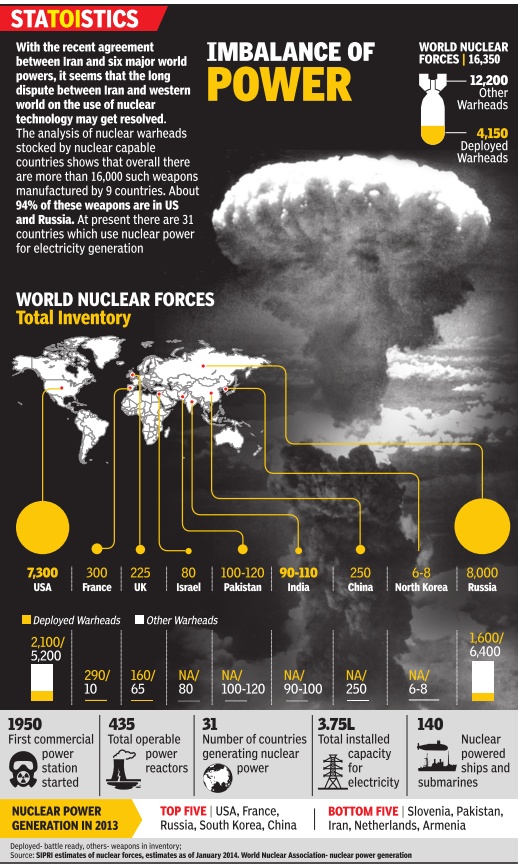
2016: Nuclear arsenals around the world
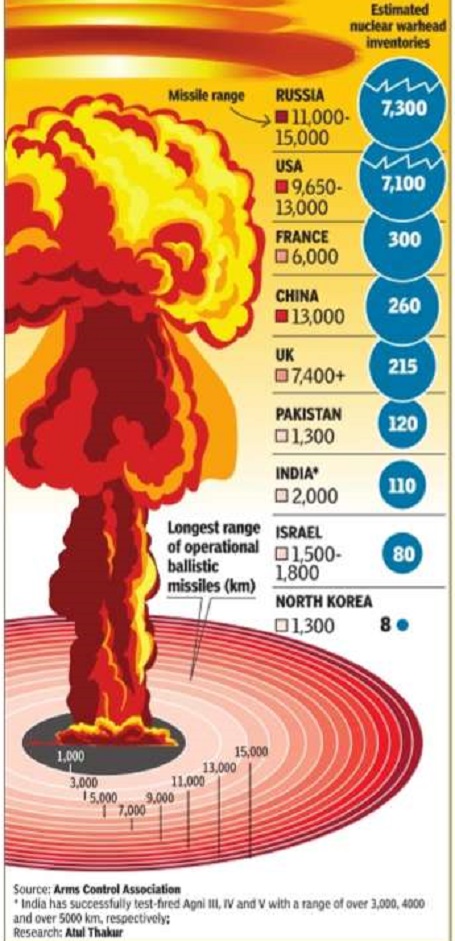
Sep 22 STATOISTICS - THERE ARE AN ESTIMATED 230 NUCLEAR WEAPONS IN THE INDIAN SUBCONTINENT, Sep 22 2016The Times of India

See graphics:
1. India, China, Pakistan number of nuclear warheads and the range of their missiles
2. India, Pakistan and the world, nuclear tests conducted as on September 12, 2016
2018: Pakistan has more nuclear warheads
Rajat Pandit, Pak has more N-warheads, India credible deterrence, June 19, 2018: The Times of India

Number of warheads- China, Pakistan and other countries;
Delivery systems- India, Pakistan and China;
India's strategic forces command
From: Rajat Pandit, Pak has more N-warheads, India credible deterrence, June 19, 2018: The Times of India
‘Nukes Not Delhi’s War-Fighting Weapon But Tool For Retaliation’
Pakistan may continue to remain slightly ahead of India in terms of the number of nuclear warheads, with China having double the quantity, but the Indian defence establishment believes its deterrence capability is “robust”, designed to ensure “survivability” for retaliatory strikes and firmly on track for further modernisation.
Pakistan now has 140-150 nuclear warheads compared to India’s 130-140, with China hovering around 280, as per the latest assessment of the Stockholm International Peace Research Institute (SIPRI), released on Monday.
The US and Russia are in a different league altogether with 6,450 and 6,850 nuclear warheads respectively, accounting for 92% of the world’s nuclear weapons.
Defence establishment sources here said India, confronted with the collusive threat from China and Pakistan, has no other option but to systematically build nuclear deterrence that is “credible” and capable of inflicting massive damage in a retaliatory strike to any first strike by an adversary.
“Number of warheads does not really matter. With a declared no-first use nuclear policy, India is keen to ensure survivability and credibility of our assets and NC3 (nuclear command, control and communication) systems for assured secondstrike capabilities,” a source said.
Pakistan has deliberately kept its nuclear policy ambiguous to deter India from undertaking any conventional military action despite repeated provocations, even as it steps up development at the Khushab nulear complex with help from China.
“For India, nuclear weapons are not war-fighting weapons. But we need credible minimum deterrence, with the certainty of massive retaliation,” the source said. It is estimated that India would like to achieve a stockpile of around 200 warheads in the next decade.
The tri-Services Strategic Forces Command is in the process of inducting India’s first intercontinental ballistic missile, Agni-V, which can reach the northernmost region of China with a range of 5,000km. But the continuing lack of an adequate number of nuclear-powered submarines armed with long-range nuclear-tipped missiles, needs to be plugged to achieve a credible nuclear weapons triad. “Projects are underway to achieve this,” the source said.
As in 2021
Rajat Pandit, June 15, 2021: The Times of India
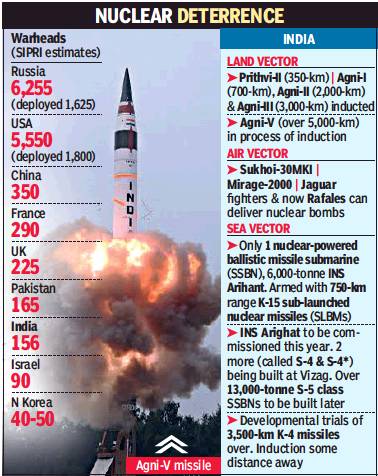
From: Rajat Pandit, June 15, 2021: The Times of India
India is confident of its strategic deterrence capability, which will get a greater punch with the ongoing induction of Agni-V missiles and Rafale fighters as well the commissioning of nuclear submarine INS Arighat this year, though it still lags behind both China and Pakistan in the number of nuclear warheads.
China now possesses 350 nuclear warheads, while Pakistan has 165, as compared to 156 of India, as per the latest assessment of the Stockholm International Peace Institute (SIPRI).
The nine nuclear-armed countries together possess an estimated 13,080 nuclear weapons, with Russia (6,255 warheads) and the US (5,550) leagues ahead of the rest. The others are France (290), UK (225), Israel (90) and North Korea (40-50). These figures, of course, are not exact because countries by and large keep their nuclear weapons programmes shrouded in secrecy.
Apart from Russia and the US, all the other seven countries are also either developing or deploying new weapon systems. “China is in the middle of a significant modernisation and expansion of its nuclear weapons inventory, and India and Pakistan also appear to be expanding their nuclear arsenals,” said SIPRI.
The report comes at a time India and China remain locked in the military confrontation in eastern Ladakh, which erupted in May last year, with no signs of de-escalation as yet. But the fresh border ceasefire with Pakistan has held since February. Indian officials say robust delivery systems like land-based ballistic missiles and nuclearpowered submarines with ballistic nuclear missiles (called SSBNs), with “assured second-strike capabilities”, have more strategic significance rather than the actual number of warheads.
“Nuclear weapons are meant for deterrence, not warfighting. Pakistan, of course, has benefitted from its nexus in nuclear and missile proliferation with China and North Korea. But India is doing fine with the development and modernisation of its indigenous credible minimum deterrence,” said an official.
The tri-Service Strategic Forces Command, for instance, is now inducting the over 5,000-km range Agni-V intercontinental ballistic missile, which brings the whole of Asia and China as well parts of Europe and Africa within its strike envelope, after shorter-range missiles.
Similarly, the new Rafale jets have boosted the existing “air vector” for delivery of nuclear gravity bombs after some Sukhoi-30MKIs, Mirage-2000s and Jaguars were earlier modified for that role.
But the third leg of the “nuclear triad” is still far from being credible. India currently has only one SSBN in INS Arihant, with 750-km range K-15 nuclear missiles. Countries like the US, Russia and China have SSBNs with well over 5,000-km range missiles. India has three more SSBNs under development.
2022
Rajat Pandit, June 14, 2022: The Times of India
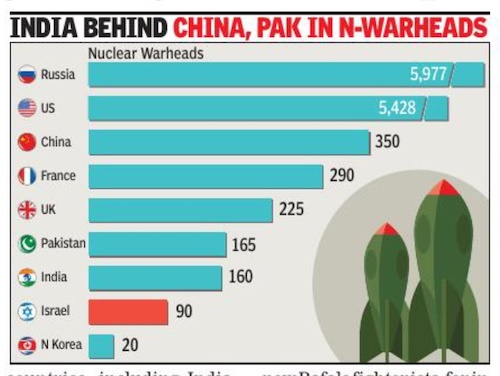
From: Rajat Pandit, June 14, 2022: The Times of India
New Delhi: According to the latest Stockholm International Peace Institute (Sipri) report, nine nuclear-armed countries together possess an estimated 12,705 nuclear warheads (see box). The US and Russia together account for 90% of all nuclear weapons around the globe.
A Pentagon report on China’s military capabilities had earlier said Beijing’s “accelerating pace” of nuclear expansion will e nable it to have up to 700 deliverable nuclear warheads by 2027, with the stockpile touching 1,000 by 2030.
“All of the nucleararmed states are increasing or upgrading their arsenals and most are sharp ening nuclear rhetoric and the role nuclear weapons play in their military strategies. . . This is a very worrying trend,” said Wilfred Wan of Sipr.
The warhead figures are estimates because most countries, in cluding India, keep their nuclear weapons programmes shrouded in secrecy. Moreover, deterrence cannot be reduced to simplistic bean counting of the number of warheads.
India is steadily moving ahea d to modernise its nuclear arsenal with better delivery systems, in tune with its declared policy of “credible minimum deterrence” and “no firstuse”, officials say.
The induction of the 36 new Rafa le fighter jets, for instance, has strengthened the “air vector” for delivery of nuclear gravity bombs after some Sukhoi-30MKIs, Mirage-2000s and Jaguars were earlier modified for that role.
The ongoing induction of the over 5,000-km range Agni-V intercontinental ballistic missile, which brings the whole of Asia and China as well parts of Europe and Africa within its strike envelope, in turn, has boosted the “land vecto r”.
2022\ SIPRI
Rajat Pandit, June 13, 2023: The Times of India
New Delhi: China continues to rapidly expand its nuclear weapons arsenal, as does Pakistan albeit slowly, but India remains confident of its strategic deterrence capabilities with induction of new-generation Agni ballistic missiles and nuclear-capable Rafale fighter jets. China now has 410 nuclear warheads, up from 350 in January 2022, while Pakistan has 170 and India 164, as per the latest assessment of the Stockholm International Peace Institute (Sipri).
“Depending on how it decides to structure its forces, China could potentially have at least as many inter-continental ballistic missiles as either the US or Russia by the turn of the decade,” it said.
Pentagon’s latest report on China’s military capabilities has also warned that the country will field a stockpile of about 1,500 warheads by 2035 if it continues with the ongoing acceleration in its nuclear programme.
The Sipri report said both India and Pakistan appear to be expanding their nuclear arsenals, with the two introducing and continuing to develop new types of delivery systems in the shape of missiles.
“While Pakistan remains the main focus of India’s nuclear deterrance, India appears to be placing growing emphasis on longer-range weapons, including those capable of reaching targets across China,” it said.
Overall, all the nine nuclear-armed states continue to modernise their nuclear arsenals. Russia and the US together possess 90% of the global inventory of an estimated 12,512 nuclear warheads. The numbers are Russia (5,889), US (5,244), France (290), UK (225), Israel (90) and North Korea (30), as per Sipri.
India has been taking steps to consolidate its nuclear delivery systems, especially the Agni series of ballistic missiles. Just last week, the first “pre-induction night launch” of the new-generation Agni-Prime was undertaken by Strategic Forces Command.
Missiles, nuclear capable, land- based
Their range, as in 2019

The likely impact of a nuclear war between India and Pakistan
From: August 29, 2019: The Times of India
' See graphic ‘:
The range of India and Pakistan’s nuclear capable, land- based, ballistic missiles, as in 2019
The likely impact of a nuclear war between India and Pakistan.
India’s Nuclear and Strategic Commands

ii) India’s Strategic Forces Command
iii) Nuclear balance among India, Pakistan and China
From: Rajat Pandit, Entire China could soon be within India’s N-strike zone, January 19, 2018: The Times of India
See graphic:
i) India’s Nuclear Command Authority;
ii) India’s Strategic Forces Command
iii) Nuclear balance among India, Pakistan and China
